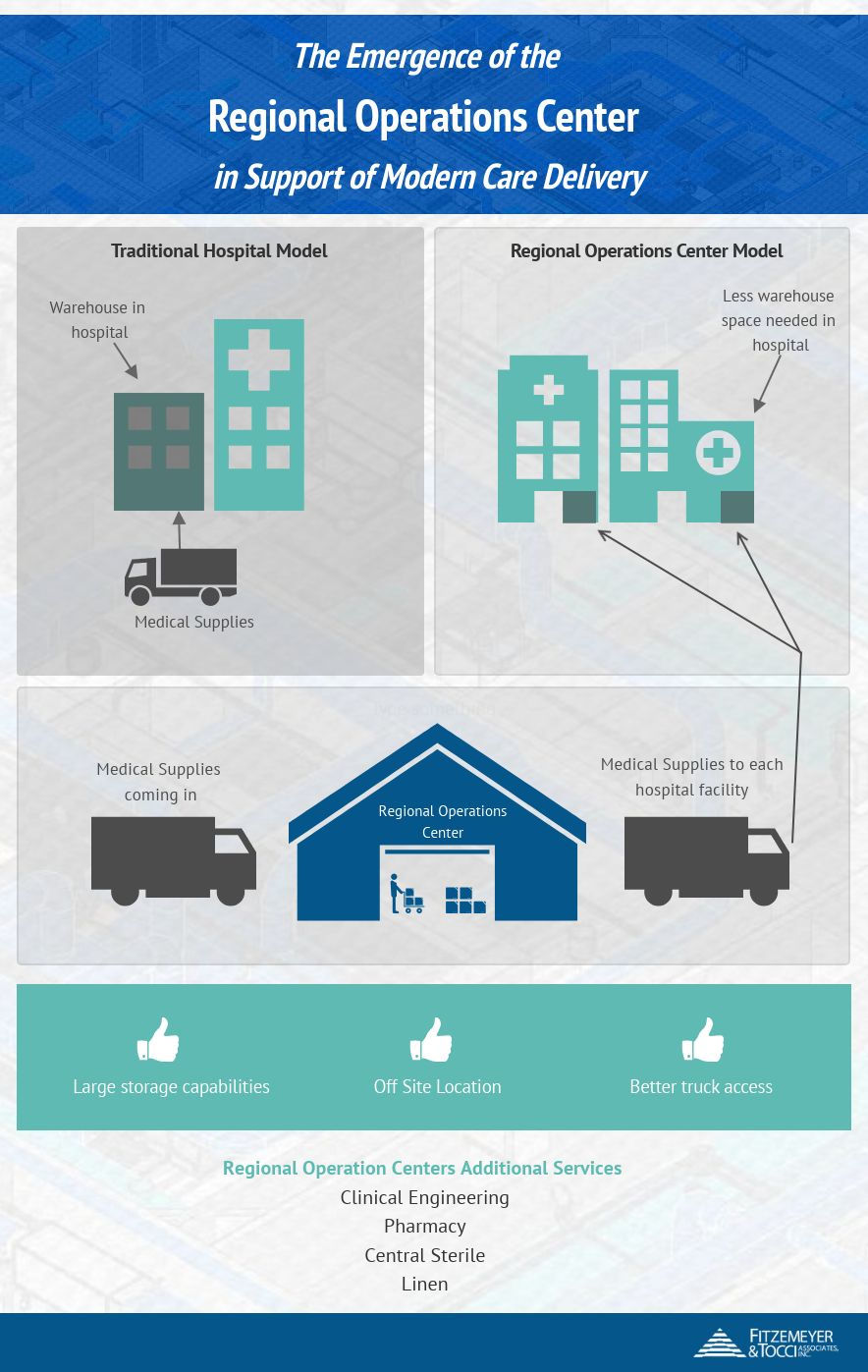Is there a more challenging building type than a hospital?
- Fitzemeyer & Tocci

- Jan 2, 2020
- 4 min read
Updated: Jan 2, 2020
The technology dimension is daunting, the patient care challenge enormous, emergency care always in crisis, labs in cramped quarters, Operating Rooms in short supply. Where, in all this, is the space and organization for satisfactory delivery and storage of supplies and equipment? How do you transport vast quantities of materials through the same hospital corridors that patients are moved in, that physicians and assistants run up and down, and that visitors visit? How do you schedule deliveries, accommodate truck traffic, store vast quantities, monitor inventory, and manage distribution in the same facility that ambulances arrive at, babies are born in, the sick are attended to and staff are working?
Solution: A Regional Operations Center. Store the stuff off-site, convenient to a network of healthcare facilities, free of conflict with other activities. Automate storage, build-in flexibility for evolving demand, computerize inventory management, and provide ample loading dock area for bulk delivery. This is a solution that frees up floor area in the healthcare facility, provides significant savings by allowing bulk buying, and increases the efficiency of ordering and stocking essential supplies. Hey, not a bad idea!
Code: But be careful how you store that stuff! Don’t install shelving that can interfere with sprinkler coverage, and keep all stored items below 12’ in height. Try to avoid dead-ends in aisles between shelves, and maintain common path of travel distances to 100’ maximum. If your Regional Operations Center is less than 12,000 s.f. it may not be sprinklered, in which case common path of travel is limited to 75’ and the maximum exit access travel distance is 200’ (that’s the distance to the nearest exit).
Sprinklers: Installing sprinklers even if you don’t need them, could be a good idea. Inevitably much of the material to be stored will be combustible, and the cost of a single fire loss is likely to exceed the cost of designing, installing, and maintaining a sprinkler system. Statistics show that most fires are extinguished by a single sprinkler head, so the resulting water damage from discharge will be minimal. If there is any concern that operations could damage a sprinkler head cages can be installed to protect heads without impacting coverage.
Occupants: While the purpose of a Regional Operations Center is storage and efficient distribution, at least one full-time employee, and perhaps more in shifts or working as teams, will be inhabiting the Center 8-10 hours a day. This is far more time than they will spend in their homes or anyplace in between. In order to enhance productivity and well-being and limit employee turn-over the ROC should be provided with human amenities such as daylighting and views, hopefully to natural features (not only do patients heal faster with such views, but children learn more quickly and employees work more efficiently and remain healthier). If designed properly daylighting can also be an energy conservation strategy, reducing the need for artificial lighting during daylight hours.
Accessibility: Accessibility for all is a consideration even in employee-only areas. Level parking with posted signage adjacent to an accessible entrance allows individuals with mobility impairment to access the ROC. While shelving will of necessity exceed the reach ranges of wheelchair users, a differently abled employee can successfully operate an automated facility and maintain an inventory database, if the environment is appropriately designed.
Human Factors: Human factors for the design of computer stations and break rooms should also be considered. Even in a fully automated facility at least one employee must be present to oversee operations. Their comfort and well-being will be as critical to the operation of the ROC as all the computerized equipment put together. Something as simple as an operable window can give an individual a sense of agency and control over their environment, with corresponding impact on motivation and self-worth. Lighting levels and background noise from HVAC systems all contribute to or detract from the quality of the felt experience. While a simple concrete slab may suffice as a floor for the storage function, any office or break area deserves a more comfortable walking surface.
Rx for Health: Finally, a Regional Operations Center need not be an anonymous box. Even if it is in a secluded location, visited only by staff and delivery personnel, every person approaching, entering, and occupying this building will be responding to visual cues received from the materials, composition, and scale of the building elements. These responses are instinctual but measurable, autonomic reactions of the central nervous system to our environment that have evolved to guarantee our survival. When this is fully understood the aesthetic dimension of a building’s design becomes as significant as its functional efficiency. The human brain devotes 50% of its neural pathways to visual processing. The overwhelming majority of visual input bypasses our conscious awareness, and is monitored instead by lower brain systems that trigger fight or flight responses. Signals of danger or well-being are received and responded to without the participation of our frontal lobes, where conscious decision making occurs. If we design a building that triggers fight or flight, as a windowless façade has been shown to do through the monitoring of neural responses, we are inviting discomfort and “dis-ease”. Architects, like Doctors, should be encouraged to adopt the Hippocratic Oath, “Do No Harm”, because, as science and experience have shown us, our built environment determines our health in ways as profound as any prescription.





Comments